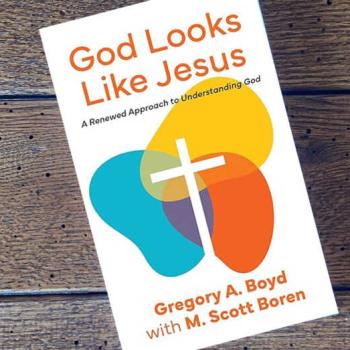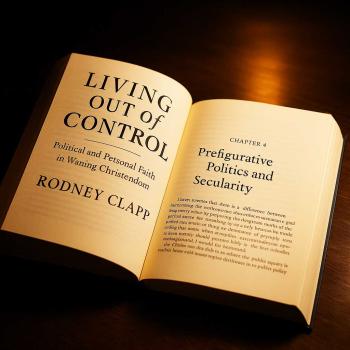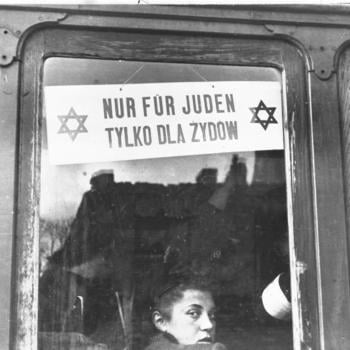Review of Apostles of Reason: The Crisis of Authority in American Evangelicalism by Molly Worthen (Oxford University Press) Part One
This review will appear in three parts corresponding with the three parts of the book. This first installment covers the book’s introduction and Part I: Knights Inerrant.
(Feel free to skip the first nine paragraphs which are autobiographical. The review of Worthen’s book actually begins with paragraph ten.)
I admit to having a weakness for books about evangelicalism. Evangelicalism is my spiritual family and reading books about it can be almost an emotional experience. Few of them have resonated with me as powerfully as this one (which happens to be the most recent of scores that I have read). Worthen’s book is not just a book of facts; it’s her interpretive history of evangelicalism—especially so-called “neo-evangelicalism” (more about that later).
When I was growing up in a pastor’s family with many close relatives in ministry I was well aware that we were most definitely evangelicals. As I look back on my home church and denomination now I realize we were also fundamentalist Pentecostals. I knew then that we were Pentecostals even though we preferred the label “Full Gospel.” However, throughout my childhood and youth we spoke the language of American evangelicalism and evangelicalism’s heroes were ours—especially Billy Graham. The music that filled our home was “gospel music”—on “Christian radio” and from evangelically-produced “sacred albums.” Our home and church were filled with evangelical publications. I was raised on childrens’ stories such as “The Sugar Creek Gang” series.
We thought of ourselves as “special” evangelicals. We were “Full Gospel” evangelicals. Baptists, Evangelical Free (my grandparents’ church), Evangelical Covenant (my aunt’s and uncle’s church), Nazarenes, Church of God (Anderson, Indiana) (the church of many of my relatives and the one in which my father was baptized at age 16), Christian Reformed (other relatives’ church), were “Not Quite Full Gospel” evangelicals. But we felt a real kinship with those churches and many others we distinguished with ourselves from “nominal Christians” (so-called mainline Protestants and Catholics).
My uncle was president of our little Pentecostal evangelical denomination for twenty-five years. He served on the boards of both the National Association of Evangelicals and the Pentecostal Fellowship of North America. As I grew older and became more actively interested in our religious “family tree” he and I had many discussions about all things Pentecostal and evangelical. It was he who informed me that we were “conservative” and “evangelical” but not “fundamentalist.” We were not the latter because we were not cessationists (which in our informal taxonomy, anyway, all fundamentalists were by definition). We also didn’t practice “secondary separation”—refusal of Christian fellowship with all who didn’t agree with us. Compared with hard core fundamentalists we were downright ecumenical.
My father read and introduced me to magazines such as The Christian Herald and Eternity and Christianity Today. (He also read The Sword of the Lord but often only to laugh at it or borrow a sermon outline from it.) We watched both Billy Graham crusades and Oral Roberts healing meetings on television (when we had a television). Our ideal Christian hero would be a hybrid of Graham and Roberts. When it came to the past our heroes of the faith were (after Jesus and the apostles) Luther, Wesley, Finney, Moody, Amy Carmichael, Fanny Crosby, Aimee Semple Macpherson, Billy Sunday, A. W. Tozer, and, later, Kathryn Kuhlman, John Stott, Alan Redpath (Keswick) and David Wilkerson.
My father attended all the local Evangelical Ministerial Alliance meetings and participation in Youth for Christ was taken for granted—as much as was church attendance. I saw every Christian film from “Without Onion” to “The Tony Fontaine Story” to “The Restless Ones” as a kid. (We didn’t go to movie theaters but often viewed these and many other gospel-themed films at churches and YFC events.)
Eventually I graduated from an evangelical Bible college and an evangelical theological seminary. My published piece was a book review for Eternity. Then I graduated to writing book reviews and articles for Christianity Today. I taught theology at two evangelical universities over seventeen years and have for the past fourteen years taught theology at a broadly evangelical seminary. Most of my sixteen books have been published by evangelical publishing houses. I edited evangelically-inclined Christian Scholar’s Review for five years and served two years as co-chair of the Evangelical Theology Group of the American Academy of Religion. I wrote The Westminster Handbook to Evangelical Theology at the publisher’s (Westminster John Knox Press) invitation. My most recent writing effort was a lengthy chapter on “The Fragmentation of Evangelical Theology” for a forthcoming volume on evangelicalism to be published in 2014 by Columbia University Press).
All that is to say that being evangelical in both senses (ethos and movement) has been part of my identity for sixty-one years. So whenever a new scholarly book on evangelicalism appears I buy it, read it and often review it.
(Review of the book begins here…)
I first heard of Worthen’s book while writing “The Fragmentation of Evangelical Theology” for the forthcoming book The Future of Evangelicalism edited by Mark Silk and Candy Brown. An anonymous reviewer of my chapter’s manuscript suggested I read and incorporate material from Worthen’s book into my chapter. It was too late for that, but I bought the book at AAR/SBL in Baltimore in November and have begun reading it. At first I swore I wasn’t going to use my usual red marking pen to underline. I was just going to read for enjoyment. But after a few pages I started marking up the book with red (which designates interest, not criticism).
I do not know Worthen or anything about her other than what it says on the dust jacket. She is a historian who teaches at The University of North Carolina at Chapel Hill. But from this book I know that she is a meticulous researcher. She’s also a very good writer. One of the most interesting things about the book for me is that she sprinkles her narrative of neo-evangelicalism with quotations from arcane sources—letters from neo-evangelical leaders to each other (for example).
It’s important to know what this book is about. It’s not about “evangelicalism in general” although there’s a lot of good information and interesting interpretation about what I call the “evangelical ethos”—a style of Christian spirituality and theology that was born out of the Pietist movement of the late seventeenth and early eighteenth centuries and was shaped especially by the “awakenings” (revivals) of the 1730s-1740s and the first decades of the nineteenth century. This book is mainly about neo-evangelicalism—the term founder Harold John Ockenga preferred for the postfundamentalist “new evangelicalism” that started formally with the National Association of Evangelicals in 1942 and 1943.
One thing I like very much about Worthen’s book is that it tracks almost exactly with my own interpretations of these subjects. Although she does not use the language of “ethos” versus “movement” (as distinct if inseparable things) she presupposes it. Throughout Part I she juxtaposes the Ockenga-inspired movement of postfundamentalist neo-evangelicalism with the wider evangelicalism of much of conservative Protestant Christianity in America—including non-fundamentalist Pentecostals, Pietists, Holiness churches and ministries, and Anabaptists. This is what I mean by “evangelical ethos” versus “evangelical movement.” The former is that spirituality with a conservative doctrinal component shared by many diverse Protestant traditions. The latter is the quasi-ecumenical evangelical movement begun by Ockenga and friends in the 1940s to move beyond fundamentalism’s anti-intellectual, schismatic, separatistic, and insular ethos that it acquired between the 1925 Scopes Trial and the late 1930s.
For example, Worthen notes in the Introduction that Jonathan Edwards and Count Zinzendorf were “among the very first evangelicals.” (6-7). She could have thrown John Wesley in there for good measure. She argues that evangelicalism is “a creature of the Puritan and Pietist revivals.” (6) As I said, throughout Part I she discusses at great length and in great detail the interactions between diverse denominational expressions of this evangelicalism (spiritual ethos) and neo-evangelicalism (postfundamentalist movement).
One of Worthen’s main themes is that Ockenga’s and Carl Henry’s neo-evangelicalism always was and still is (as represented by Christianity Today, for example) heavily Reformed. Putting this in my own language, her point is that neo-evangelicalism privileges Reformed theology and more or less expects other evangelicals (Holiness, Pentecostal, Anabaptists, Restorationist) to adjust to that to be acceptable. And many non-Reformed evangelicals have succumbed to that pressure while others have resisted it—causing tensions among evangelicals and within denominations.
Another point where Worthen and I agree is about neo-evangelicalism’s failure to extricate itself from fundamentalism completely. She highlights and provides evidence for neo-evangelicalism’s founders’ and leaders’ inability to leave the fundamentalist past behind. Two examples are their obsession with biblical inerrancy and their concern for certainty through authority. I would add their continuing separatism. When a past leader of the NAE suggested eliminating the rule that member denominations could not also be members of the National Council of Churches he was so heavily criticized by fellow neo-evangelicals that he had to resign.
Another point of agreement is that inerrancy became a mere shibboleth among neo-evangelicals, a test of evangelical fidelity without real meaning. As I have often argued, and as Worthen demonstrates, so long as one is perceived as adequately conservative and loyal to the evangelical cause and untainted by liberal theology he or she can define “inerrancy” just about any way and be accepted by conservative evangelical leaders.
One of Worthen’s main points is that, according to her, anyway, neo-evangelicals sought a unifying authority not so much in the Bible, as they claimed, as in a Reformed epistemology—presuppositional apologetics combined with Common Sense Realism combined with Calvinism combined with biblical inerrancy that formed the “groundwork for an ideology.” (46) Carl Henry is her main case study and illustration of this.
Here is one example of her conclusion (and excellent writing):
“The neo-evangelicals were refugees from churches conquered by modernists a generation earlier, and this freed them to preach across denominational lines. Yet when it came to institution-building, a separatist hangover combined with the ideological mindset of the early Cold War to dampen any ecumenical spirit.
Scratch a neo-evangelical and underneath you would likely find a fundamentalist who still preferred the comforts of purity to the risks of free inquiry and collaboration. Their efforts did not calm evangelical anxieties over the place of the Bible in modern life: Instead, they institutionalized them.” (46)
Worthen goes to great lengths, into great detail, to argue that fear of liberalism (accommodation to modernity and secularity) drove non-Reformed evangelicals who did not have a history of affirming biblical inerrancy and who were by-and-large free of the influences of Princeton Orthodoxy (Alexander, Hodge, Alexander, Warfield, Machen) to seek shelter under the neo-evangelical umbrella and to imitate neo-evangelical institutions.
I would put it this way. For neo-evangelicals the theology of Charles Hodge, B. B. Warfield, and J. Gresham Machen (largely stripped of Warfield’s openness to evolution) served as the interpretive framework, a kind of informal magisterium, for developing theology. Alternative evangelical theologies were expected to adapt to it to be accepted into the neo-evangelical fold. Pentecostal, Holiness (e.g., Nazarene), Anabaptist (e.g., Mennonite) and Restorationist (e.g., Independent Christian) did not have the Princeton theological influence, but gradually adapted it (here and there, with controversy) in order to “fit in” with neo-evangelicalism because it was the best game in town—for fighting off liberalism and fundamentalism.
One thing that really strikes me about Worthen’s book (so far) is her inclusion of non-Reformed theologians in her story of evangelicalism and neo-evangelicalism. For example, she discusses at some length the life and ministry of H. Orton Wiley, leading Nazarene theologian who tried to steer the Church of the Nazarene away from fundamentalism and neo-evangelicalism. She also discusses Nazarene theologian Mildren Bangs Wynkoop—a much neglected evangelical theologian—probably because she was non-Reformed and a woman! And she discusses Mennonites theologians Harold Bender and John Howard Yoder and their ambivalence toward neo-evangelicalism. The same with Pentecostals and Restorationists.
At one point Worthen goes so far as to agree with a critic who referred to neo-evangelicals as “fundamentalists’ more polite and articulate cousins.” (66)
Worthen says of Pentecostal, Holiness, Anabaptist and Restorationist “non-Reformed leaders [that they] conveyed…a mixed message that both pushed Reformed neo-evangelicalism away and pulled it close.” (95) I can testify to that from my own life experience. Many, many Pentecostal, Holiness, Anabaptist and Restorationist schools adopted curricula written from a Reformed neo-evangelical perspective.
Worthen concludes Part I by saying that the story of the neo-evangelical movement in America reveals “different ‘evangelicalisms’ at odds with one another over the nature of religious experience and the gathered church, and a Christian’s place in politics and culture.” (96)
Near the beginning of the book Worthen puts her finger on the main problem with postfundamentalist, “neo-evangelicalism.” She says “The sundry believers who share the evangelical label…are all children of estranged parents—Pietism and the Enlightenment—but behave like orphans.” (7) I would adjust that to say they (we) are all children of estranged parents—Pietism and Puritanism (especially Princeton Orthodoxy)—and behave like orphans.
Neo-evangelicalism tried to draw together concerned conservative Christians of disparate types to fight the hegemony of liberal Protestantism as seen, for example, in the National Council of Churches’ domination of the airwaves in the 1930s and 1940s. The founders’ Reformed theology was the implicit glue holding the new coalition together. While attempting to maintain their non-Reformed identities, Pentecostals, Anabaptists, Holiness and Restorationists (and I add Pietist Free Churches) gradually succumbed to the Reformed hegemony of neo-evangelicalism. Neo-evangelical leaders pretended to include non-Reformed evangelicals on an equal footing, but they never really intended to do that.
I have been criticized by some Reformed evangelicals for claiming that Arminians (among others) have been persecuted by Calvinist evangelicals. Worthen’s book provides support for what I say—not that we non-Reformed evangelicals are actively persecuted but that we have been patronized and treated like stepchildren by the Reformed leaders of neo-evangelicalism and that we have been accepted by them only to the extent that we take on their flavor of intellectual life and spirituality.












